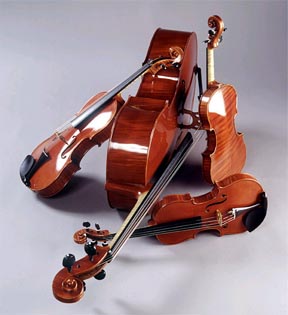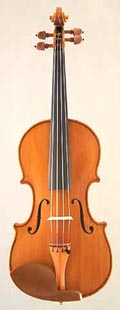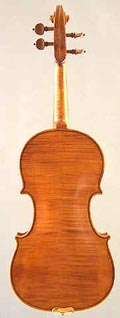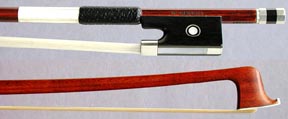The violin, viola, cello and bass fiddle - which make up the strings of the orchestra - are very similar in construction, and all work the same way. A wooden bridge carries the vibrations of the strings into the belly (front) of the instrument, and then the sound is resonated back outward by the smooth back panel. All that wood greatly multiplies the sound volume which is further amplified by the sound holes on the front. And it's all made possible by cellulose, the natural polymer that makes up wood.
In the old days the strings were made out of stuff called catgut, which is a strange name, since it was really from sheep intestine. This stringy stuff is made of tough proteins, and though it was strong and vibrated well, it was very difficult to tune becasue of its sensitivity to weather and temperatre. Now strings are made from steel or nickel wire wound with nickel, silver, or aluminum.
The strings are held taught by a set of wood pegs, and the fingerboard where the player changes the pitch of each string during playing is also wood - more cellulose!
The belly of a violin is usually srpuce, which has a density that vibrates well to amplify sound. (It is also used for piano sound boards) The back resonator is made of maple wood. The glue that holds the whole thing together is a tough adhesive made from horse hide - a form of protein. In all a vioin has about 70 individual parts. That's a lot of glue! Recently a new violin has been invented which is molded from a composite of carbon fiber. The revolutionary new design allows the maker to construct a violin from only 20 parts.
The bow which is used to vibrate the strings has a shaft made from wood which holds a tight arrangement of horsehair. These hairs are formed from protein and actually have a microscopic scaled texture which gives them friction with the violin strings. They are also treated with rosin so that they will have even better friction on the strings to make them vibrate well. The polymers in the bow also have synthetic alternatives. There are composites used for the bowstick which are made from glass fiber or carbon fiber. These materials are light and very strong - well able to handle the tension of the tight bowhairs. Speaking of the hair, there is even synthetic bowhair which can be made form nylon or fiberglass, but it is not considered as good as real horsehiar for playing.




